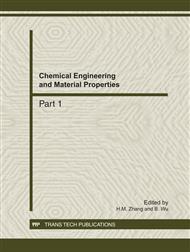p.264
p.269
p.274
p.278
p.282
p.287
p.292
p.297
p.303
Insulating and Thermally Conductive Composite Filled with Boron Nitride Particles
Abstract:
A new kind of thermally conductive composites reinforced by glass fibers with boron nitride (BN) as thermally conductive filler was prepared in heat press molding. Thermal conductivity of the composites was found to increase with increasing in filler content. But impact strength and flexural strength reach the top point, 385.05KJ/m2 and 912.6481MPa, with content of 50wt% and 20wt% respectively. The thermal conductivity of 0.8385 W/mK was obtained at 50wt% filler content. Experimental dates show that mixed matrix of epoxy (EP) and polyimide (PI) displays high thermal stability and can improve thermal stability compared to pure epoxy obviously at 50wt% PI content. Additionally, the obtained composites possess high surface resistivity and volume resistivity, which are suitable for substrate materials.
Info:
Periodical:
Pages:
282-286
Citation:
Online since:
December 2011
Authors:
Keywords:
Price:
Сopyright:
© 2012 Trans Tech Publications Ltd. All Rights Reserved
Share:
Citation:


